 |
Chris Bell | 'The man on top of the mountain didn't fall there.' |
| - Vince Lombardi |
 |
Chris Bell | 'The man on top of the mountain didn't fall there.' |
| - Vince Lombardi |
SNHU - MBA-690 Operations Management and Technology
Written by: Chris Bell - November, 2018
The potential costs of operationalization increase as WesBell enters the services market, including equipment and employees, but more importantly, more operational management and organization. When CEOs hire their first 50 employees they tend to stop looking forward and start looking inward at the operationalization but hopefully don’t take their eyes off the future. Production departments are difficult to run because they involve human behavior, management, teamwork and leadership which are all difficult tasks to fulfil. Adhering to ISO 9001 as a guide to continuous improvement and risk mitigation allows a multitude of various companies to improve monthly and annually by collecting data and using it to make major decisions. FDA.gov states, “Nonconforming Product is product that does not fulfill its specified requirements. Nonconformances can occur in both product and process. Nonconforming processes can lead to nonconforming product. (Gopal, n.d.)” Multiple errors in certain areas allow the team to find the root cause of problems quicker and to change the process when the wire harnesses are nonconforming.
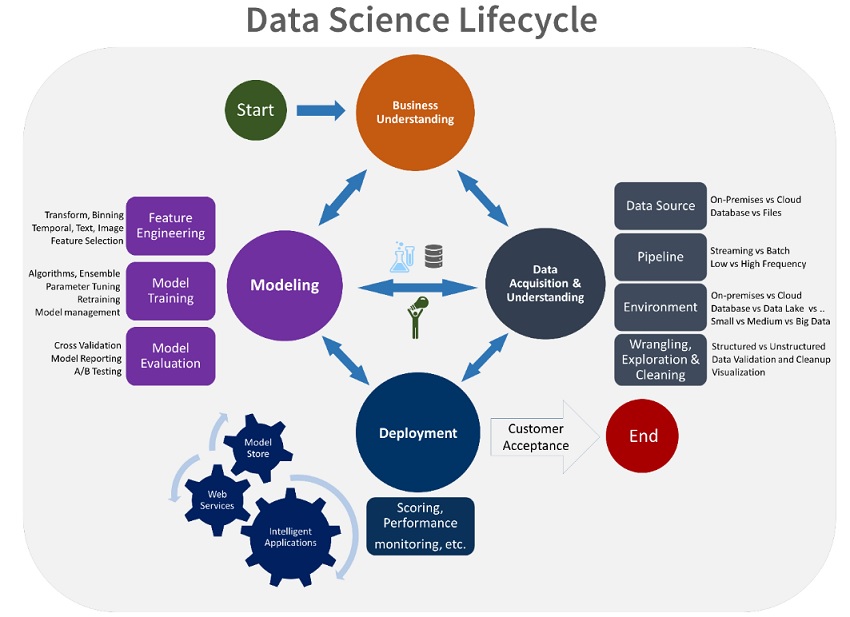
The potential risks of operationalization increase as WesBell enters the services market, including more debt, lower cash flows and the added liability of staff using production equipment and tooling daily. Companies must have a safety committee that meets regularly to pass the ISO 9001 annual third-party audits. Companies with warehouse operations also need to adhere to OSHA and MSHA regulations for health and safety reasons. WesBell’s warehouse staff went through extensive training before getting a certificate to operate a forklift it in its environment. WesBell risks failure and a burden of debt because the assets will not be easy to sell if they have problems with selling the wire and cable harnesses in additional to their product line. The tooling and equipment are specialized to wire and cable, and the warehouse space is needed for the entire operation which is a longer term financial problem if the exit plan is executed. However, they don’t need to inventory product for wire harnesses because the lead times are longer and most are specific to individual pieces of equipment.
The potential benefits of operationalization increase as WesBell enters the services market, including the opportunity to scale with ISO 9001 processes in place, performance reviews that create leaders and providing jobs at fair wage to people that want to work hard. WesBell needs to make the processes efficient while keeping employees happy, keeping them for life and empowering them to speak up and become an asset to the team. People should be treated fair and not like equipment, so WesBell should explain the quality inspection report with a focus on quality instead of a focus on not making a mistake, “or else”. Operationalization will improve the production processes, quality, efficiency and speed by collecting data, reviewing it and making strategic decisions to improve them in a cyclical pattern.
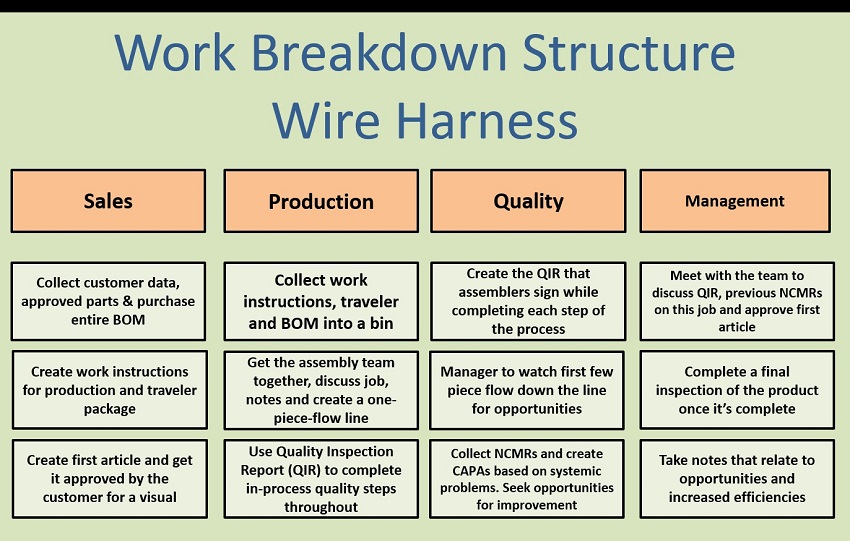
The sales person is in contact with the customer and responsible for figuring out the cost of materials, cost of labor and resale price based on the company quotation form. Once the quote is approved and the order is taken, the sales person connects with the customer to collect the latest revision of the wire harness and any specifics about the materials, such as UL, CSA, RoHS or REACH compliant or a specific manufacturer’s brand. Once the sales person enters the order into the company ERP system, they create a traveler package including the customer supplied data sheet, QIR, Risk form and previous NCMRs on the specific job. The QIR is filled out by each assembler as they complete their task. The risk form is filled out before commencement to discuss any chances for problems, errors, inefficiencies, etc. The sales person is also in charge of creating work instructions for the production department since they reviewed and quoted the wire harness initially. Perhaps there are 3 steps of cutting the wire, hand crimping a terminal to the end and inserting it into a plastic house. A job like this might take 3 people, one set up to cut the wire, one to crimp and one to insert. Finally, once the team has created two first articles for the job, one is sent to the customer for approval, and once approved, the job can start with a visual of the approved wire harness.
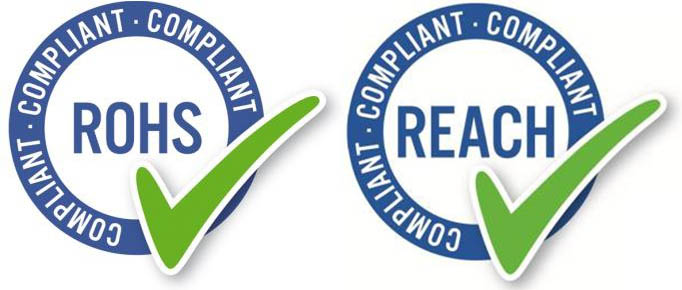
Once the materials arrive for the job, the first article is created by the production team and sent to the customer for approval, and it’s also put into the schedule based on the rough amount of time it takes to complete. The BOM and traveler package are placed into the same bin or box and await approval. Once approved, the team meets to discuss the steps of the job, the previous NCMRs, the format of the QIR and the one-piece-flow process. One person cuts the wore, one crimps it with this specific hand tool and one inserts the crimped wire into this specific house. Each of the three assemblers are required to sign the QIR after checking the quality of their step, roughly 4-5 times throughout the job. The manager always checks the first piece with the assembler, signs the QIR, and lets the team continue working. If there are 500 pieces for the job, the team stops are 100, 200, 300 and 400 to check their piece and sign again. The person cutting the wire or cable is checking the length and strip for accuracy, the person crimping is checking for the precision of the crimp and the person inserting is pull-testing to make sure it’s fully connected.
The QIR is used to be sure that the assemblers remember to check their work and the managers to see who completed each step of each job. When a customer calls to report an error, or nonconforming product, WesBell goes through a root cause analysis process to determine what happened. Was there a machine failure, human error or defective product? Typically, it’s a human error because, even when a machine makes a mistake, the human should have caught it in the quality inspection. Nonetheless, both problems are reported, an NCMR is created and the customer is notified of WesBell’s findings. When errors happen a second and third time and the root cause analysis is similar, WesBell needs to complete an internal CAPA, or corrective and preventative action report. Hopefully a few simple changes can stop the error from happening in the future. Sometimes CAPAs are issued by the customer which tells the vendor to improve the quality or risk losing the business. A formal response is requested with details about what went wrong and how it will be fixed.
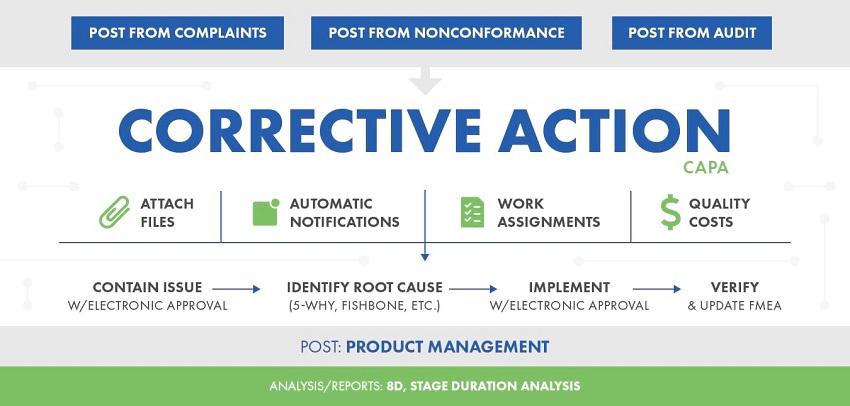
Management is prominent at the beginning and end of each job to be sure the correct materials are being used, that previous mistakes are made twice, that the team has a data sheet, QIR and customer approved sample as a visual. They set up the one-piece-flow line if possible, check the first few pieces and let the team complete most of the job without too much attention. Perhaps, they might answer a few questions along the way, but they come back when the job is completed for a final inspection of roughly 1% of the lot. Due to detailed in-process inspections, the manager can simply look for systemic issues such as a wrong length on all the parts or a wrong part used. It’s unlikely that a quality team will find a needle in a haystack, so they look for major errors one last time. The manager is also looking for opportunities to make jobs more efficient, faster without sacrificing quality and more enjoyable ways for the assemblers to work together as a team rather than whipping them to move faster without thinking about the consequences of those actions. The notes circle around because the management team reviews the job after it shipped, reviews the notes and adds any necessary notes to the data sheet for the next time the job is entered. When the sales person enters another order and prints the data sheet, there will be newly added notes for the assemblers to see.
Key milestones for operationalization of WesBell’s wire harness services will be to get certified as an ISO 9001:2015 company, train sales and production staff on the Quality Inspection Report and Risk Form, to set up the equipment and create efficient one-piece-flow production lines. Getting certified as an ISO 9001:2015 company is just the beginning of the journey for WesBell because the certificate is ongoing and cyclical as they are forced to look for opportunities for improvement, document errors and work on corrective actions for improvements in operations. However, getting certified is the first big milestone because the opposite outcome would mean they didn’t get certified and need to rethink their operationalization in terms of processes and procedures. One of the first deliverables for getting certified is to review the ISO 9001:2015 standard, document all of the processes that will be followed and be prepared to discuss them with the ISO auditor. Aside from documentation, ISO emphasizes the need for performance evaluations to let the employees know how they’re doing, to let management know who’s exceling and to find weak links in the team that need further training. Without discussing the good and bad with each employee, continuous improvement can be difficult to achieve, but also difficult to document for the ISO auditor.
Training the sales staff and the production staff to follow the processes set in place will be the next key milestone and deliverable for WesBell’s implementation of operationalization in wire harnesses. “The effectiveness of an organization will depend on the quality of the training its employees receive. An efficient company will comprise an adequately skilled and knowledgeable workforce. (Riding & Mortimer, 2000)” If the sales staff isn’t following all the steps in the process then they’ll set the production team up for failure, but with a detailed risk form filled in, QIR, customer data sheet and customer approved sample, the production team will be equipped and prepared to get the job done efficiently without mistakes, wrong tooling or missing materials. Making a few mistakes won’t be the end, however, because the ISO auditor wants to see certified companies react to mistakes as opportunities for improvement rather than seeing a lengthy list of problems that occurred. If the sales staff makes a few errors, then they need to be documented, reviewed and possibly changed for the better.
Another key milestone and deliverable for WesBell’s operationalization is to set up the equipment in order of operations and to train the staff to use one-piece-flow techniques to achieve efficiencies for quality products. It doesn’t make sense to zig zag around the production room with boxes of materials, so a systematic flow in, around and out of the room is a deliverable and an achievement to consider. Everything that cuts wire should be first in the line followed by the subsequent steps in the assembly process, then processing, then labeling station and finally the shipping/boxing station should be last before the product goes out the door. Carts and racks on wheels will help push the products from station to station around the room and the position of the rack defines the progress of the order. If the rack is stationed at the beginning, middle or end it will be easy to identify how far along the order is coming.
Potential obstacles that might get in the way of WesBell’s operationalization plan are management of staff and knowledge of the ISO standard. Management plays a key role in hiring competent people to fulfil the job description needed to follow the current processes, document errors, look for opportunities for improvement and create corrective actions that improve process flow. Management will need to evaluate employees and make decisions that move some assemblers into supervisorial positions while terminating others that aren’t showing progress. Assemblers will come and go but management is in place for longer periods of time, and they need to assess and manage their staff to achieve the outcomes of their job description. While one assembler won’t ruin WesBell’s ISO certificate or their entire operationalization plan, one manager could do a lot more damage. They’ll play a key role in avoiding the potential obstacles of training and managing the production staff to work as a team and to create one-piece-flow production lines.
Knowledge plays a key role in avoiding potential obstacles because, without the internal ISO manager creating and implementing processes that adhere to the ISO standard, it will be difficult for the company to get certified. Even if they manage to get certified and start collecting Nonconforming Material Reports (NCMR) they may struggle to implement corrective actions that improve the current processes. They may also struggle to find opportunities for improvement. The ISO auditor wants to make sure that the paperwork is in place, but more importantly they want to see that the company is finding and fixing problems while looking for opportunities to improve the company’s quality. “Companies that make effective use of ISO often cite improved quality in deliverables, reduced cost of production and shorter cycle times thanks to improved processes and higher efficiency. (Sweatt, 2008)” Customers want to buy from ISO certified vendors because they know how strict the certification process is and how those companies continue to improve over time.
One of the biggest additions to the ISO 9001 standard, as it updated from 9001:2008 to 9001:2015, is risk mitigation. There’s an old saying, “If it ain’t broke, don’t fix it.”, but that doesn’t apply in 2018. Instead, companies need to consider risk before jobs start rather than waiting for errors to address later. WesBell created a 20-question/comment risk form that reminds the sales person to think about orders before they’re entered. For example, a few questions on the risk form include, 1) Has a first article been approved by the customer? 2) Does the customer part number and revision match the current WesBell print? 3) Is the delivery date clear and attainable? Each of the 20 boxes need to be checked for prove that they completed each task, and they need to sign the form. Thinking about risk is important because following ISO 9001:2015 processes for operationalization is something that increases sales due to quality of product and meeting delivery dates.
Mitigating the risk of troublesome employees will start with the staff working in teams for each wire assembly, discussing it before working on it and inspecting the sample together. Then the team will create a first piece, inspect it and then start production. The QIR is recorded with signatures of all involved. Less than 10 columns indicate one of the ten services WesBell offers and each assembler signs accordingly. Their signature confirms that they checked the quality of their step against the customer approved sample and data sheet and this step is completed roughly 5-10 times through the job to insure everything is going smooth. “Delivering quality data is not a task to be completed at the end of a project. Quality data can only be achieved by having a robust quality process in place throughout the project, which includes all members of the team as stakeholders in its success. (GSA.gov, n.d.)” If you want to limit the risk of assembling a wooden desk that arrived in a box, you should carefully read the directions and check your work. As they work in teams and review all the documents in the traveler bin, they should have everything they need to complete the order with the upmost quality because a risk review was completed before the traveler bin was created. The ISO certificate itself mitigates the risk of accidentally holding onto troublesome employees through performance reviews, so WesBell should find them quickly through the given processes.
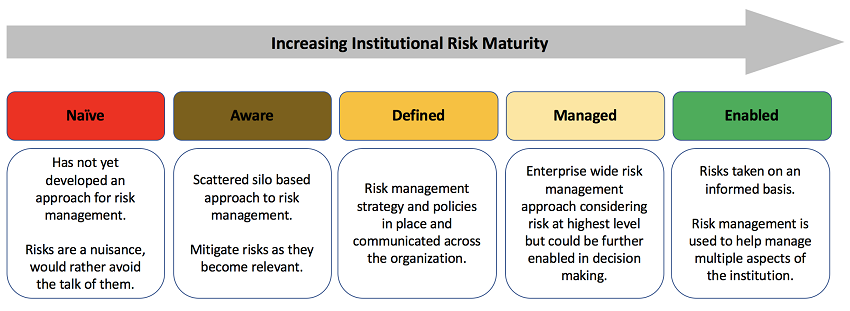
References:Gopal, V. (n.d.). FDA.gov. Nonconforming Product. Retrieved from:https://www.fda.gov/downloads/Training/CDRHLearn/UCM586411.pdf GSA.gov (n.d.). Quality Control Reports. Retrieved from: https://www.gsa.gov/real-estate/.../document-guides/quality-control-reports Riding, R., & Mortimer, J. (2000). A study of the on-the-job training of production line operatives in manufacturing companies. International Journal of Training & Development, 4(2), 111. Retrieved from: http://ezproxy.snhu.edu/login?url=https://search.ebscohost.com/login.aspx?direct=true&db=bsu&AN=4519369&site=eds-live&scope=site Sweatt, M. (2008). Why ISO should be on your radar: ISO 9001 is not just an industrial standard. In fact, it can help public procurement professionals make smart choices in today’s marketplace. Government Procurement, (2), 22. Retrieved from: http://ezproxy.snhu.edu/login?url=https://search.ebscohost.com/login.aspx?direct=true&db=edsggo&AN=edsgcl.178896707&site=eds-live&scope=site |